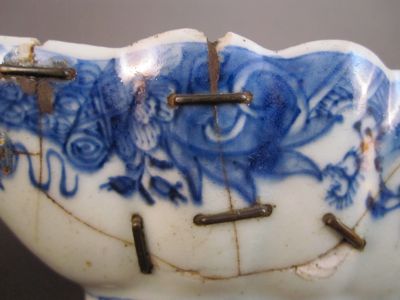The time after my father’s death.
I feel like a washing machine waiting for the agitation cycle to finish. While my hips take their sweet time to heal as an external measure of the life transition sloshing under my lid, I get out the shellack to keep myself busy and away from meddling with my interior rearrangement. Healing was never accomplished by fiddling.
Periodically I see a decaying object and know that today is the day of arrested decline. Rust climbs around the water spout of the Victorian porcelain-lined, metal-clad water urn I dredged up from the dusty recesses of the cellar, pocking it, creating a textural ombré. I will preserve you as you are this moment. My daily tea tray has begun to shed the floral arrangement my grandmother painted. I love its less-than-perfect-ness; before it was too tidy. I will stop it here. I like to stop things in mid-process, where time and wear have contributed to their original design but before they lose their functionality.
 Blue Sweater
Blue Sweater
I like layers of repair, projects involving a glop of wood glue, a coat of shellack, or needle and thread—now it’s an art piece. Yesterday I spent two hours mending my father’s blue lambs wool sweater. At first I carefully darned the small holes so the fabric wouldn’t buckle, but as time went on I got lazier; the last few mendings pucker. Still, the sweater feels better today; it wanted my attention, wanted me to care for it, let it continue its work in the world. It has plenty of life in it. Perhaps this, rather than the habits of the Great Depression, is why older people mend their clothes. They empathize. They have plenty of life in them and just need mending from time to time. In the right proportion, mended clothing becomes more interesting, but it has to have the wearer’s evolution in it, not faux designer rips. Most items we throw out have a lot of wonderful life in them. My father mended a lot, mostly his wooden sloop or broken China cups, which he did inexpertly but enough to get by for a while. For me, this created great relaxation. I knew that favorite things were loved enough to be taken care of.
Lily
While I heal, subtleties reveal themselves, like the pleased look/feel of Dad’s new/old sweater. Now I know the lilies better. The first ebullient vase-ful of Stargazers arrived on the mantlepiece during the last days of my father’s life; they continued blooming and caressing the room after he died, his body gone to the fire. Stargazer Lilies begin closed, stems of green pods waxy and neat. Their tips open tentatively, bellies swelling, streaking pink near the stem. Then, gathering confidence, they burst and splay wide into fragrant laughing tongues with brilliant, deep pink throats. Days and days of softly shifting color and gushes of cooling perfume follow before they drop their petals which exude a piquant Lily of the Valley scent when you bend to them. There is not one day of a lily that isn’t pure joy and amazement. The only thing to watch out for is its pollen the color of turmeric that clings ferociously to fingers and nose and clothing.
Everything I see around me is a sign.
Everything whispers.
Everything is an altar.
And everything says relax, you don’t need to make sense of this. You’ll understand soon…
 Thanks for reading and for sharing this with friends.
Thanks for reading and for sharing this with friends.
Not getting weekly blog notifications? Email me with ‘blog list’ in the subject line:
dervish@dancemeditation.org


everything is an altar……mending things that still have perfectly good life in them…..not meddling with my interior rearrangement…….I love the philosophy of all of this…..letting things happen in their own good time…..not staying in fear around bodies and their workings…..cups and saucers and lilies……everything is an altar…….
Karleen, sending love and appreciation to you for being the Wide Heart receiver.